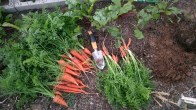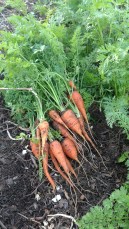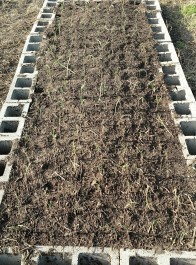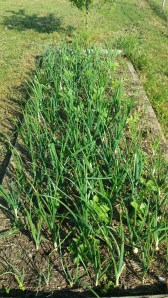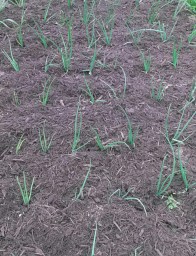With my new dehydrator up and running, I’ve been busy. This week, I harvested the last bunch of carrots and they are now stored, dry, in canning jars.
Tag Archives: Root Veggies
Now Harvesting Carrots!
Although the harsh freeze (down to 19 degrees Fahrenheit) damaged much of the Fall/Winter garden, these carrots survived and we are now enjoying the benefit of covering them with frost cloth and tarps! Continue reading
Plant Onions Now (8b, 9)
In USDA Zone 8b and 9, it is time to plant onions for a spring harvest.
Onions require cooler temperatures for growth and Continue reading
Carrots are Ready for Harvesting!
The carrots are ready for harvesting.
We usually pull a few at a time Continue reading
Harvesting and Drying Onions
We planted red and white onions on February 1, 2014. Once the green above ground onion leaves were about 4 inches, in March, mulch was added to the raised bed.
Onions signal that they are ready for harvest when the green portion bends at the “neck” and falls over (see “Onion Plant Bending at Neck”). Some people harvest when about 1/4 of the total onion crop has bent to the ground, but we harvest each onion as it indicates it is ready. Continue reading
Onions and Sunflowers
This year, we decided to try something different— growing onions and sunflowers together. As we are in USDA zone 8b, we put onions in the garden in February and then sunflowers after danger of frost.
Fresh Mulch on the Onions — Check!
Over the weekend, weeds were removed from among the onions and mulch was added. Despite several days of well below freezing temperatures over the past four weeks, these onions look pretty healthy above ground!
Onions generally need 100 to 120 days from planting to harvesting. These were planted from seed onions on February 1, 2014 (read blog post). We’ll start watching for signs of maturity for harvesting in Mid-May.
Onions are ready to harvest when the base of the green stalk bends and the thin green leaves are lying on the ground (pictures of maturity for harvest will be provided in an updated post at harvesting).
Onions planted!
In this area (USDA Zone 8b in Texas), onions can be planted at now
When preparing to grow onions in the garden:
- Purchase onion varieties that will grow in your area. These onions (pictured above) were purchased from our local Co-OP. The two kinds of onions we planted are; Texas Legend (yellow onion) and Hybrid Southern Bell Red (red onion).
- Check if the ground temperature range is 45 to 60 degrees (preferred temperature range for successful onion growing).
- Remove weeds from the garden bed.
- Plant onions about 6 inches apart and 2 inches deep in the soil.
- Wait until the green tops fall over on the ground before harvesting.
The picture below illustrates that the white bulby part of the onion is not visible above ground.
Onion Trivia: Long Day versus Short Day Onions.
Select an appropriate class of onion for your region. In Southern states, the soil is sufficiently warm in February, so plant short day onion varieties. In the northern states, it will be at least late April until the soil temperature is minimally warm enough, so plant long-day onions.
Why? Spring days are shorter than Summer days — long day onions will not grow in the southern heat conditions (when day length is longer), so in Southern states, plant early and use short-day onions for best growth during Spring/early summer.
Multiple Root Carrot
Because of the super moist Fall (combined with limited time available for gardening), we were unable to work in the garden nearest the house (reserved for carrots, spinach and Fall green beans).
Last year, we planted carrots and had so many that some of them stayed in the ground long enough to make seeds that were scattered (by wind) onto the soil.
When carrot plants are not thinned out as young plants, they tend to interfere neighboring carrots’ growth and have odd shapes, or develop multiple roots if there is an excess amount of nitrogen. As a consequence, we’ve seen quite a few “odd” shaped carrots — this one (left) is the oddest so far.
Fresh Carrots!
Finally, we have a picture-perfect weekend; no wind, lots of sun and a high temperature expected to be right about 70! I decided to check on the carrots in the garden. We did not plant any in the Fall due to the rain and excessively soaked ground, however, we do have carrots in the garden now.
Last year’s weather was perfect for carrots — our garden produced about 30 pounds or so. The carrots were harvested in December, with a few in January. I let some of them continue growing until seed was produced–the seed apparently had no problem germinating without help from us!
The surprise was from the 10 inches of ground adjacent to the landscape timbers of our raised bed (yard just adjacent to garden).
The top picture shows carrot plant growth, the bottom picture shows the carrots that were pulled from the ground beneath the plants.
The carrots are all 4 to 6 inches in length, the largest diameter on a carrot is about 1.1 inches. Of course, we’ll have them for supper!
